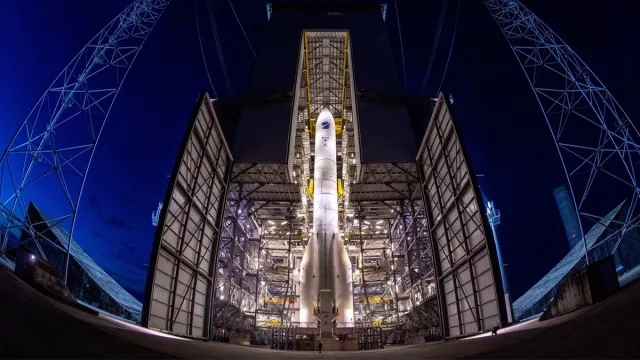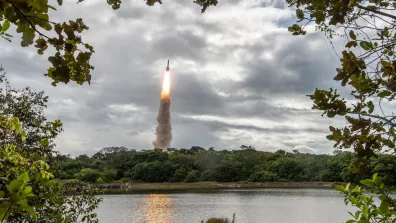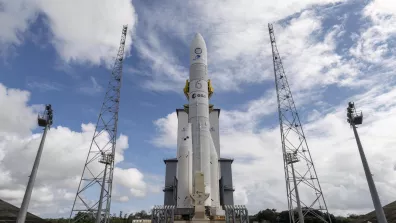To retain its own independent launch capability and meet its customers’ increasingly diverse needs, the European Space Agency (ESA) set in train the Ariane 6 programme in December 2014.
Key information
| Mission | Space transportation |
|---|---|
| Domain | Space transportation |
| First launch | 9 July 2024 |
| Partners | ESA, ArianeGroup |
| Launch base | Guiana Space Centre |
| Service lifetime | Indefinite |
| Status | In service |
Key figures
- 11 launches scheduled per year
- 62 m high
- 3,500 kN maximum thrust
- 2 variants: A62 and A64
Key milestones
- 9 July 2024: First Ariane 6 flight
- 2023: Combined testing of launcher and systems on the launch pad
- Mid-2016: Final Ariane 6 configuration frozen by ArianeGroup
- 1 December 2014: Final configuration adopted by ESA Council of Ministers
- 2012: Work started on defining Ariane 6 architecture
Project in brief
With Ariane 6, Europe’s heavy-lift launcher is set to offer two variants, Ariane 62 with two boosters and Ariane 64 with four, and a reignitable upper stage capability. This will afford greater flexibility in lift capacity and reachable orbits, while significantly reducing the cost of space launch. Its maiden flight was successfully completed on 9 July, 2024, from the Guiana Space Centre.
Ariane 64 will have four solid-rocket boosters, giving it the ability like Ariane 5 to place two telecommunications satellites into geostationary transfer orbit and multiple satellites for large constellations. Ariane 62, meanwhile, will have two boosters and is therefore designed chiefly to launch scientific satellites, Galileo positioning satellites and Earth-observing satellites into low and medium Earth orbits, while also offering the capacity to loft a single satellite payload into geostationary orbit.
Both variants of the launcher feature an upper stage powered by the new Vinci engine, capable of reigniting to inject one or more satellites into very specific orbits. Ariane 6 also has two new P120C solid-rocket boosters and a new 2.1 version of the Vulcain engine. Technology innovations include additive manufacturing (AM) and friction-stir-welding to fabricate the launcher’s propellant tanks.
Ariane 62 has a lift capacity of more than 10 tonnes into low Earth orbit (LEO) and five tonnes into geostationary orbit (GEO). Ariane 64 is able to loft more than 20 tonnes into LEO and 11 tonnes into GEO. Ariane 62 also offers the ability to take payloads of up to seven tonnes into Sun-synchronous orbit. The launcher stands 62 metres tall and weighs 530 tonnes for Ariane 62 and 860 tonnes for Ariane 64.
CNES’s role
ESA is providing programme oversight and has delegated responsibility to ArianeGroup for the design and integration of Ariane 6, as well as for marketing launch services through its Arianespace subsidiary. It has appointed CNES as prime contractor for development of ground facilities in French Guiana, which include a new launch pad and alterations to the spaceport.
CNES is also providing oversight support to ESA and conducting combined tests in French Guiana with ArianeGroup, the launcher prime contractor, in addition to its prerogatives under the French Space Operations Act (FSOA).
CNES contacts
Ariane 6 Project Leader
Olivier Bugnet
E-mail: olivier.bugnet at cnes.fr
Head of Space Transportation Strategy
Philippe Pujes
E-mail: philippe.pujes at cnes.fr





